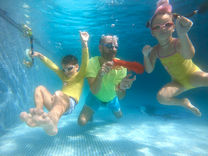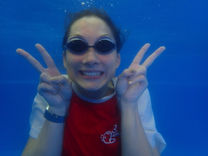Baby swim alphabet: What should parents know about baby swimming?
Ever since I started my baby swimming story and working with babies, especially when I got my own babies, I proved to myself even more that babies love spending time in the pool as they swim. Children who swim as babies not only have a strong immune system and better muscle tone, but sleep better, and their motor skills are much more developed. I practiced baby swimming with my kids twice a week, and we still do it. It’s important that they spend time in the water, playing and being relaxed.
It is up to us, parents – whether and how to use what has been given to us.
Frequently asked questions about baby swimming:
When should your babies start swimming? Your baby can take up swimming at any time, before or after the immunisation, even when he or she is 45 days old. My advice for taking your babies to a swimming pool, under your own and the supervision of a swimming professional, should happen when they are six months old. However, for those passionate lovers of water, like me and my kids, there is a chance to “jump” into the pool at the age of four months. At least that is what I did with my kids. It really depends on a child. In the same way some children start walking when they are seven, nine or thirteen months old. However, when they are six months old, babies are interested in different surroundings and activities, they have a good control over their neck and the parents could enjoy swimming with them.
Do you need a certificate issued by a physician for baby swimming? Yes. Because in that way the instructor will know if the baby develops properly and can enjoy swimming. If there is a “problem” either physical or mental, or with the baby’s skin, the physician will state that in the certificate and give a recommendation for baby swimming. In this way, every baby will be approached adequately. Every baby is unique and has his/her own progress pace, so parents should not make comparisons with other babies and other parents in the water but focus on the needs of their own children and how to satisfy them.
“In terms of swimming” all children can attend baby swim lessons. The only thing which can prevent a baby from attending baby swim lessons is when they are suffering from a temporary infectious disease which can leave a trace in the water, and therefore pose a risk to other children in the pool.
How long does it take for a baby to adapt? It’s important that the baby gets into the pool voluntarily. In the first introduction with the water in the pool, and swimming, the accent should always be placed on a comfortable fun of parents with babies, with the note that babies should never be forced to do anything they don’t want to do. Water was a child’s natural surrounding before he or she was born, and baby swimming is just a way in which your child can continue enjoying this pleasant environment.
Should I breastfeed my baby before or after swimming? You can breastfeed your baby at any point, anywhere, even during the lesson. However, it is recommended not to breastfeed your baby right before the lesson, due to active moves in the water and possible baby spit-ups. If you breastfeed your baby an hour before the lesson, the baby will definitely be much calmer and you will be more relaxed. Babies spending time in the water from an early age, swimming together with their mum and dad are unlikely to make a fuss when it comes to the lunch time. It won’t take them long and they won’t sleep while breastfed. When my kids started eating solid food they weren’t picky at all, and they still aren’t. Of course, they will tend to be thirsty after swimming. Please, give them water, not the coloured juice.
Will my child learn how to swim in baby swim lessons? Your baby won’t learn how to swim crawl-style or butterfly! Babies and children do not have the basic motor skills to make certain swimming freestyle moves until they are four years old. However, babies can be independently mobile in the water long before they are of this age.Instead of using the traditional swimming techniques, they use the primitive-instinctive strokes to move in the water. Their moves, when they are young, reminds us of dolphins swimming and playing under the water surface. So, what does “child swimming” at a very early age involve? First of all, a joy of movment and active play in the water, bathing with other mums and dads with kids, and all that in the surrounding created and adjusted to a full enjoyment and pleasure of little “swimmers”.
What can a two-year-old kid do in the water? It depends on the kid and other factors too. To start with, it is important if you are with your child in the water from an early age and how often you do that. If you are with your kid in the water at least once a week, and later even twice a week, everything is possible. I can say from my own experience with baby swimming that children of two to three years of age can fearlessly jump into the water on their own, move underwater, turn and swim to the pool’s edge all by themselves, reach a prop from the pool’s bottom under the surveillance of a professional. With maturity and curiosity of children, the level of movement in the water increases and children gradually become independent. Baby swimming is a chance to enrich the child’s world and make him/her love water through a play.
Can the water activities accelerate the mental and motoric development of children? Based on the cooperation and research done by physicians it has been confirmed that swimming develops motoric and intellectual potentials of children. But it is not the accelerated development that matters, but the development of those capacities which are useful not only for swimming, but also for everyday life “on the dry”, affecting many other abilities children are unlikely to develop without water.
What happens if your baby gags on water? Of course, it is not easy to see your child gagging on water, and I’ve been there many times with my own and other babies. But with these short dips into the water we teach or remind them how to hold their breath, and they will not harm your baby but actually help them acquire an important skill, that could potentially save their life one day… Therefore, don’t worry, and remember, if you are relaxed in the water, so will your baby be. Believe me, they can feel everything, your moves, your grip, body posture, tone of your voice… literally everything.
Who should the baby get into the pool with? With the parents, of course, but grandpas and grandmas are always welcome, as well as aunts, uncles and other family members who can replace the parents. Twins need the support of two family members. We recommend that mothers who have had a delivery should wait for at least six weeks before entering the pool, especially if they had a C-section.
Who can teach baby swim lessons? Trained and certified instructors for baby swim lessons and child swim lessons are entitled to teach baby swim lessons. The most important thing for you is to get the information about the competences of the instructor, since only those instructors with years of work experience can make a sophisticated organisation of the lessons, have a proper and fast communication, be able to correct “mistakes” and motivate children to work and swim! Also, the important thing affecting the satisfaction of children or babies in the pool is the way the lesson is organised by the instructor and the way how he/she communicates with the children and the parents.
What does a baby swim lesson involve? The best baby swim lessons are those involving a lot of simple activities adjusted to the babies, with lots of songs and play, with gentle dives that are very carefully designed. The songs and rhymes provide a smooth stimulation and they are the most efficient way to communicate with your baby. Repetitions are fun and soothing, and promote learning, both for babies and their parents.
What should we take with us to baby swim lessons? Good mood is enough for the beginning, and also swim diapers for your baby (you can find them in all well-stocked stores and pharmacies), while parents should wear a swimsuit that fits them well (it doesn’t matter if the mum has a one-piece or two-piece swimsuit), and the other things you take with you are those you usually take to any other swimming pool. You don’t need goggles for you or your baby.
Should the pool be adjusted to babies? It is important to make sure that, whenever you take your baby to the pool, you do it gradually and in a controlled surrounding. Babies must not be exposed to the sun, and the water must be warm (minimum 30°C), to make a proper and comfortable surrounding for the baby to learn how to swim. If the baby is cold in the water, do not force it. Wait for the right moment, because the first impression is the most significant one.
Cleanliness of the pool: The hygiene can’t be guaranteed if you fail to take a proper care. The PH value in the pool must be between 7.5 – 7.8, while the chlorine level should be between 0.1 – 0.3 pml. The pool’s surrounding should also be adjusted to the parents with babies and small children. The parents should also follow the health (hygiene) and safety codes of conduct at the pool, since in that way they themselves will contribute to the cleanliness and order at the pool.
Relax and swim with your baby, but don’t forget to have fun and enjoy it together! Why? Because active movements are important for your child from the very early years, especially if they are made in the water. Baby swimming also brings fantastic emotions, memorable moments that parents spend with their babies, the moves developing their mental abilities, psychological characteristics and movement itself.
When you introduce water to your baby’s world, the parenting routine gets a different perspective.
Try it and enjoy it with your babies in the water.
























































Comments